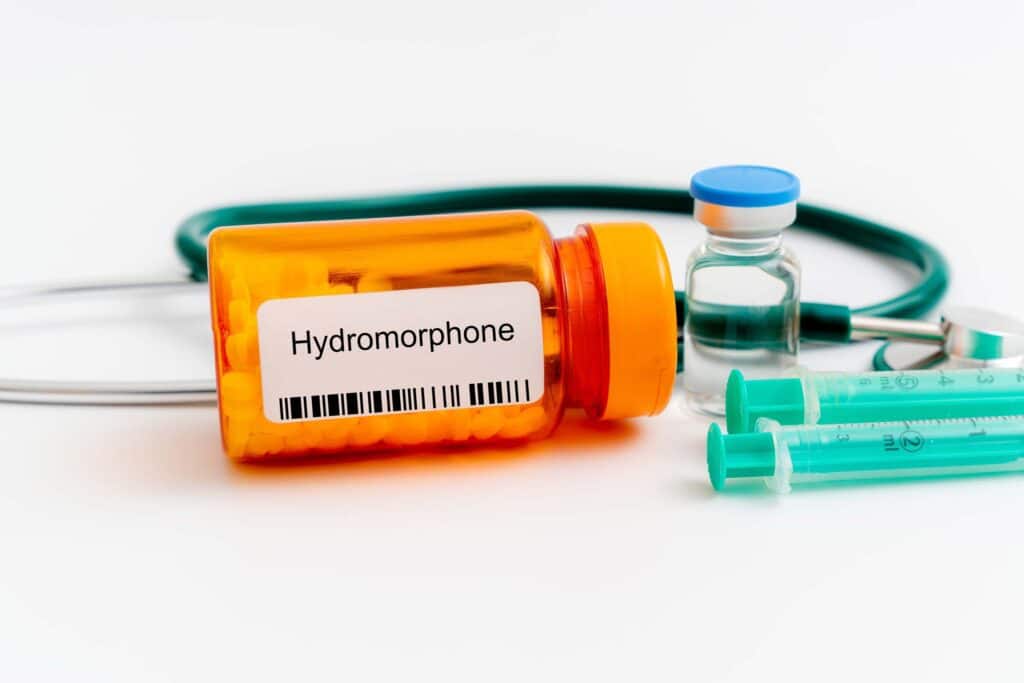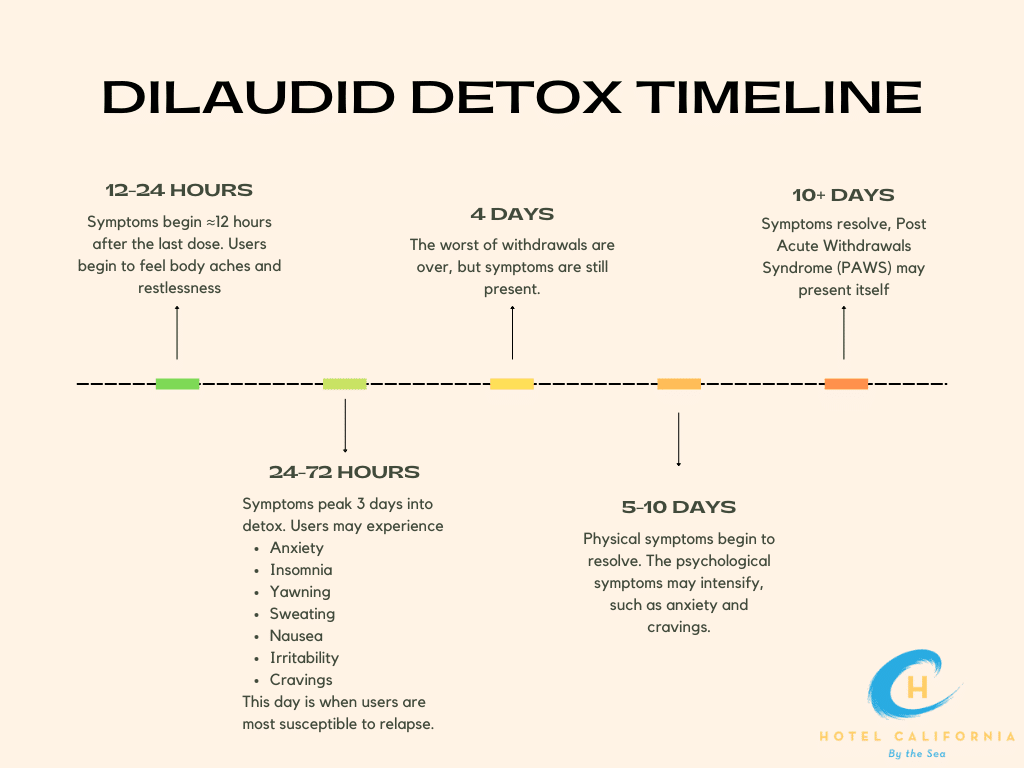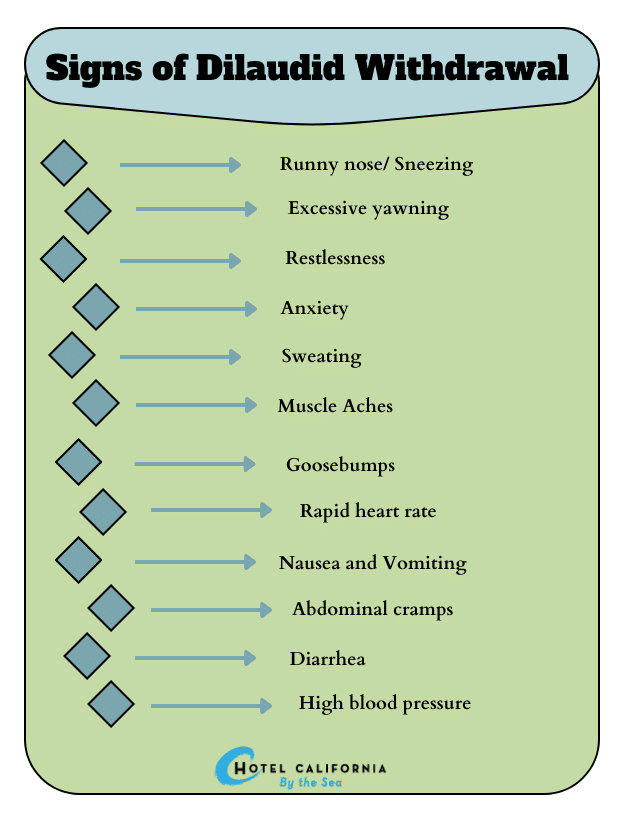How long does Dilaudid stay in your system?
Dilaudid, also known as hydromorphone, is a semi-synthetic opioid analgesic that is derived from morphine. The Schedule II Controlled Substance works by providing relief of moderate to severe pain. It is eight times more potent than morphine and has a high potential for abuse and a tolerance to the drug can develop in as little as two weeks of continual use. Dilaudid is an opioid and produces similar opioid effects such as feelings of euphoria and intense relaxation. The drug is a short-acting opioid and doesn’t stay in the system as long as some longer-lasting opioid pain medications.

Dilaudid is an opioid agonist that affects the central nervous system. It binds with the pain and pleasure receptors. Attaching to these opioid receptors interrupts the transmission of pain signals from the body to the brain. This creates a chemical reaction that alters the way the body perceives pain. It triggers the body to release excess amounts of dopamine in the brain. Meanwhile, the drug is stimulating the reward center of the brain letting it know that it is an important and pleasurable process and should be repeated.
It results in feelings of relaxation, euphoria and drowsiness. When this starts to happen, the brain will naturally begin to produce less dopamine on its own and rely on the drug to produce the chemicals. It is often prescribed as a pain management replacement and comes in tablets, capsules, oral solutions, and injectables as well as extended and immediate-release formulations. Common street names include D, Dust, Juice and Smack.
How long does Dilaudid stay in your system?
The length of time Dilaudid stays in your body can be dependent on many different factors. For an immediate-release formula, the half-life of the drug is between two to three hours. The effects can begin within 15-30 minutes and can stay effective for an average of four to five hours.
For an extended-release formula, the half-life is around 11 hours. In some cases, the half-life can extend up to 15 hours. The effects can work within six hours and can remain effective in the body for about 13 hours. Immediate-release formulas can stay in the body for under a day, while extended-release formulas can stay in the body for up to three days. Ultimately, the powerful painkiller stays in your system for an average of one to three days.
For an injectable formulation, the effects of Dilaudid can begin within five minutes and last for up to 19 hours. The half-life is an average of 2.3 hours. Those who abuse the drug often manipulate the method of ingestion. Changing the way the drug is ingested can change the onset of effects and duration of effects in an unpredictable way.
In drug test screenings, a blood test can detect the opioid for up to 10 hours after the initial dose. A saliva test can detect the opioid for up to six hours after the initial dose. And a urine test can detect the opioid for up to 24 hours after the initial dose.

Dilaudid Addiction
Dilaudid produces feelings of euphoria, relaxation, reduced anxiety, reduced pain and sedation. These desired side effects prompt users to continue using the drug, which can sometimes lead to dependence and addiction. Dilaudid has a high potential for abuse and can lead to users becoming addicted through overusing the drug, turning to fake prescriptions, or using the drug in combination with other mind-altering substances.
Signs of Dilaudid Addiction:
- You are obsessed with the next dose of drugs
- You spend excessive time and money on drugs and fail to keep up with your responsibilities
- You need larger doses to feel the effects
- You are neglecting friends and family
- You are stealing from your friends and family
- You are forging prescriptions or buying them off the street
Users with fake prescriptions often turn to illicit means of obtaining the drug. The street value of Dilaudid can range anywhere from $5 to $100 per tablet depending on the location, supply and demand of the drug. Because Dilaudid generally has a shorter half-life than most opioid drugs, some users find they need to take the drug more often in order to achieve the desired effects. When the effects wear off users will take more despite the drug still running throughout their system. This causes a toxic build-up of opioids leading to addiction and overdose.

Physiological and psychological side effects of abuse:
- Dry mouth
- Nausea and vomiting
- Constipation
- Dizziness and headache
- Adrenal insufficiency
- Coma
- Seizure
- Suicidal thoughts
- Sleep apnea
- Respiratory depression
- Drug dependence
- Mental clouding
- Changes in mood and behavior
- Restlessness
- Nervousness
- Withdrawal symptoms
In cases of polysubstance abuse, when users mix Dilaudid with substances such as alcohol and benzodiazepine, users have a higher chance of developing an addiction to one or both substances. It is regularly used with these other drugs because they are all central nervous system depressants and produce sedative effects. It can result in difficulty breathing, stroke, coma, stomach pain, collapsed veins, seizures, heart problems and death.
Check Your Insurance Coverage for FREE
Find out if your insurance covers addiction treatment in minutes. We accept most insurance!
Dilaudid Withdrawal Timeline
- The first 12 hours. During the initial phase of withdrawal, users will begin experiencing initial symptoms which include anxiety, irritability, and restlessness.
- Day 1 and 2. This is during the time of peak symptoms which can peak after the first 14 hours. Side effects can include nausea, chills, muscle aches, runny nose and watery eyes, difficulty sleeping, fever, depression, loss of appetite, chills and sweating.
- Day 3 and 4. During this phase withdrawal begins to fade.
- Day 5-15. At this point, the majority of symptoms will begin to wear off. However, there are lingering ones that include insomnia, depression, anxiety and drug cravings.
On average, Dilaudid withdrawal can last anywhere from 10-14 days. Common medications used to help during the detoxing process include Clonidine, buprenorphine, and other over-the-counter medications. Acute withdrawal is the beginning phase of experiencing withdrawal. Oftentimes, during this phase, users feel anxiety, agitation, insomnia, runny nose and diarrhea. During the prolonged withdrawal phase, users can experience abnormal cramping, nausea, diarrhea, goods pumps dilated pupils.
The best way to detox from Dilaudid is through a tapering method. Because the opioid has become so addictive to the user, gradually decreasing use can help reduce intense symptoms of withdrawal and keep cravings down.
Reach out to Hotel California by the Sea
We specialize in treating addiction and other co-occurring disorders, such as PTSD. Our Admissions specialists are available to walk you through the best options for treating your addiction.
Treatment for Substance Use Disorder
Dilaudid is a short-acting synthetic opioid. This means its effects are felt quickly and leave as quickly as they started. Like other opioids, there is a high risk for abuse and addiction. At Hotel California by the Sea, we specialize in prescription pain medication treatment. Our program provides treatment at all levels of care including detox, residential and outpatient. Clients can expect a combination of medication-assisted treatments as well as intensive individual and group therapy.
We utilize evidence-proven methods such as CBT, DBT and EMDR therapy to help clients understand the root causes of their addiction and possible co-occurring mental health conditions. Hotel California by the Sea provides clients with the environment, tools, resources and support they need to overcome their addiction.
References:
https://www.deadiversion.usdoj.gov/drug_chem_info/hydromorphone.pdf
https://www.rehabcenter.net/hydromorphone/detection-time/
https://vertavahealth.com/hydromorphone/
https://anrclinic.com/hydromorphone-withdrawal-detox/
https://www.bicyclehealth.com/opioid-education/dilaudid/how-long-in-your-system
https://www.addictioncenter.com/opiates/dilaudid/
https://www.dea.gov/sites/default/files/2020-06/Hyrdromorphone-2020_1.pdf
https://www.ncbi.nlm.nih.gov/books/NBK470393/
